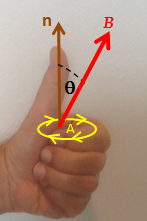Faraday's law of induction
Faraday's law of induction
Faraday's law of induction is a fundamental principle of electromagnetism predicting how a magnetic field will interact with an electric circuit to produce an electromotive force (EMF). This phenomenon is known as electromagnetic induction.
History[edit | edit source]
The law is named after Michael Faraday, who conducted extensive research on electromagnetic induction in the early 19th century. Faraday's experiments demonstrated that a changing magnetic field within a closed loop of wire induces an electric current in the wire.
Mathematical Formulation[edit | edit source]
Faraday's law of induction can be mathematically expressed as:
- \[ \mathcal{E} = -\frac{d\Phi_B}{dt} \]
where:
- \(\mathcal{E}\) is the induced EMF,
- \(\Phi_B\) is the magnetic flux through the circuit,
- \(t\) is time.
The negative sign in the equation represents Lenz's law, which states that the direction of the induced EMF and the resulting current will oppose the change in magnetic flux that produced them.
Applications[edit | edit source]
Faraday's law of induction is the principle behind many electrical devices and technologies, including:
Related Concepts[edit | edit source]
See Also[edit | edit source]
References[edit | edit source]
External Links[edit | edit source]
This article is a electromagnetism-related stub. You can help WikiMD by expanding it!
Search WikiMD
Ad.Tired of being Overweight? Try W8MD's physician weight loss program.
Semaglutide (Ozempic / Wegovy and Tirzepatide (Mounjaro / Zepbound) available.
Advertise on WikiMD
|
WikiMD's Wellness Encyclopedia |
| Let Food Be Thy Medicine Medicine Thy Food - Hippocrates |
Translate this page: - East Asian
中文,
日本,
한국어,
South Asian
हिन्दी,
தமிழ்,
తెలుగు,
Urdu,
ಕನ್ನಡ,
Southeast Asian
Indonesian,
Vietnamese,
Thai,
မြန်မာဘာသာ,
বাংলা
European
español,
Deutsch,
français,
Greek,
português do Brasil,
polski,
română,
русский,
Nederlands,
norsk,
svenska,
suomi,
Italian
Middle Eastern & African
عربى,
Turkish,
Persian,
Hebrew,
Afrikaans,
isiZulu,
Kiswahili,
Other
Bulgarian,
Hungarian,
Czech,
Swedish,
മലയാളം,
मराठी,
ਪੰਜਾਬੀ,
ગુજરાતી,
Portuguese,
Ukrainian
Medical Disclaimer: WikiMD is not a substitute for professional medical advice. The information on WikiMD is provided as an information resource only, may be incorrect, outdated or misleading, and is not to be used or relied on for any diagnostic or treatment purposes. Please consult your health care provider before making any healthcare decisions or for guidance about a specific medical condition. WikiMD expressly disclaims responsibility, and shall have no liability, for any damages, loss, injury, or liability whatsoever suffered as a result of your reliance on the information contained in this site. By visiting this site you agree to the foregoing terms and conditions, which may from time to time be changed or supplemented by WikiMD. If you do not agree to the foregoing terms and conditions, you should not enter or use this site. See full disclaimer.
Credits:Most images are courtesy of Wikimedia commons, and templates, categories Wikipedia, licensed under CC BY SA or similar.
Contributors: Prab R. Tumpati, MD







